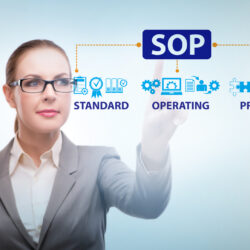The efficiency of any office or operation depends on workflow. The better a manager clearly defines a regular process, the more efficient their team becomes. This saves overall work time, making the team more effective and able to do more with less stress or frustration. At the end of the day, efficiency leads to bigger bottom-line profits. To streamline work processes and improve workflow, assess the entire operation from top to bottom, looking for areas of improvement.
If you don’t take the time to refine your business systems and processes, you will be paying costs across every area of your business. Without your systems and processes refined, documented and delegated well, you will find that you’re paying a cost across five key areas.

“To need a process and not install it, is like paying for it, without getting it.” – Ken Stork
DOCUMENTATION OF INTELLECTUAL PROPERTY:
Let’s face it, professional knowledge and intellectual property are messy businesses. Valuable ideas don’t flow in a smooth, orderly manner from inventive minds. They come in fits and starts. They are hammered into useful products only through great vision and persistence. Likewise, the transformation of ideas into valuable intellectual property is an exercise in the management of chaos. If your systems and processes are not documented and laid out for everyone in plain black and white, there will be too much knowledge of business operations locked up both in your mind and in the minds of your team members. Unlocking that information is to maximize it.
OPTIMISATION OF BUSINESS PROCESSES:
The second cost that you’ll be paying in your business if you have not refined and documented your systems and processes, is that of optimisation. Optimising a business process requires more effort than simply purchasing a new software. It requires taking a critical look at an organisation’s operations and minimising the resources required to get things done. You might have a clear idea of what might be happening but if you haven’t mapped that out, and then look for ways to improve and optimise your processes, there will still be opportunities for improvement that are never possessed. There will still be money and time being wasted. There will still be confusion and inconsistency. So the optimisation of your operations relies on you prioritising the development and streamlining of your systems and processes.
ABILITY TO AUTOMATE:
The next cost you’ll be paying is in your ability to automate. Automation necessitates a certain amount of clarity about an effective system in the delivery of your products and services. If you don’t know the tasks involved and the people responsible for running the process, you can’t design and automate the workflow accurately. Unless you have a very clear picture of what the process looks like manually, you will not be able to build effective automation of that process. The insights you gain from analysing an automated process can clearly show you the gap between your process as it is and as it should ideally be.
OUTSOURCING:
The next cost you’ll incur by not refining your systems is your lack of ability to outsource. For most small business owners, outsourcing means having someone outside the business do work. But the inevitable question arises: how do you make sure the quality stays the same? How can you possibly outsource a task that is not optimised, streamlined or documented? You can’t possibly pass on a task if you don’t have a clear idea of exactly what a good job looks like, what needs to be done to complete that task and how the person will know that it’s been done well. So, the opportunity to outsource can only be realised when you’ve got your processes documented and your tasks optimised.
DELEGATION:
Whether you’re outsourcing to third-party suppliers, or whether you’re delegating to people in-house, a good job is documented so well it can be repeated by another. If the task is not repeatable by someone else then you simply cannot create a growing business. It is vital that if you’re growing a business bigger than yourself and you’re on a mission to roll out your products and services nationally and even globally, you stop and take a look at the infrastructure that you’re relying on to sustain that growth. You must install the processes that you need because the last thing that you want is to be paying for processes without actually getting them.
Streamlining your business removes wasteful or redundant steps to improve efficiency. In business, time is money, so a small business achieves key financial and operational advantages from streamlined operations. You reduce costs, attract more customers through nimble response times, drive higher revenue and compete effectively. When is the best time to streamline your processes? As the Chinese proverb says, “The best time to plant a tree was 20 years ago, and the second-best time is today.”









